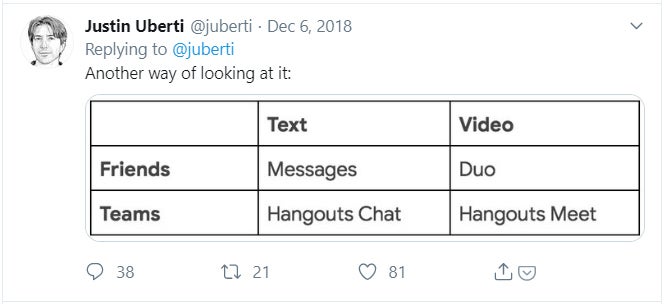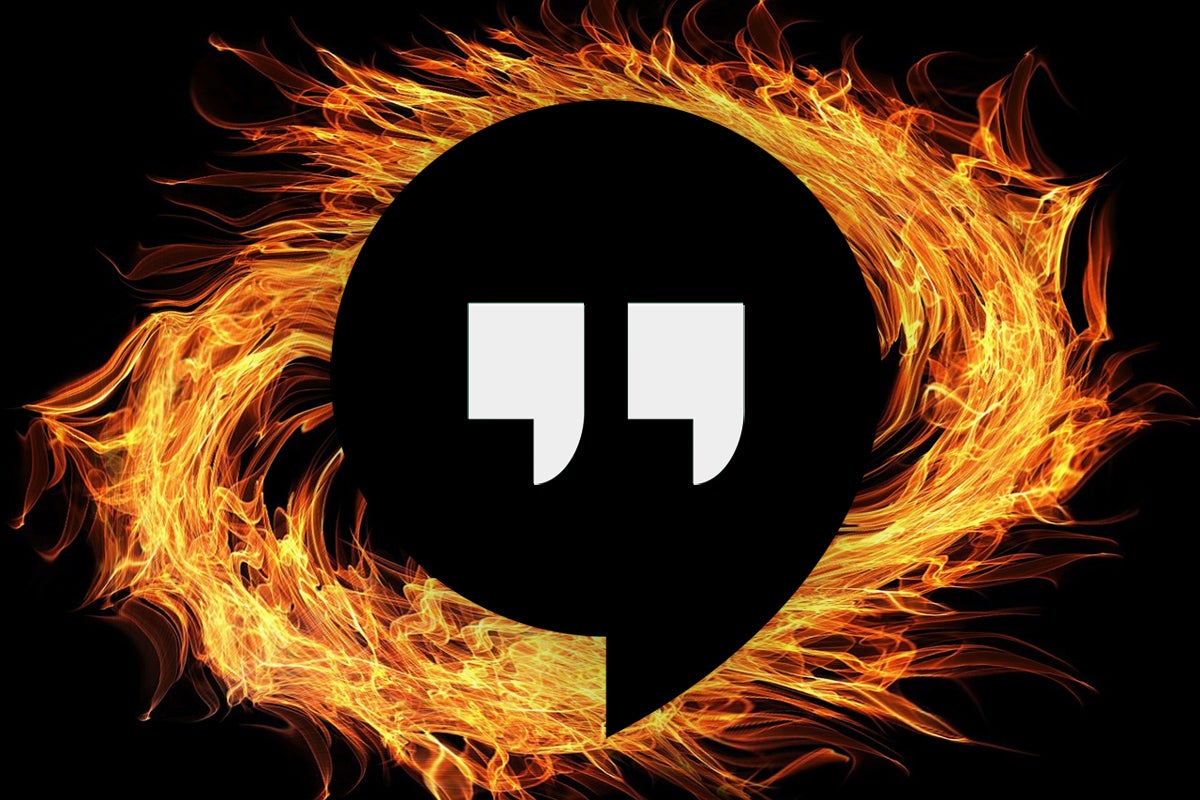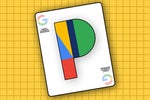For a minute there, I thought Google might have actually been on its way to a clear and sensible strategy for its mess of messaging services.
That sentiment started a little over a year ago, in December of 2018. Back then, y'see, Google announced it was "pausing" all work and investments in Allo, the A.I.-injected chat service it had launched with lots of fanfare and little sense of purpose two years prior. With that distraction out of the way, we were told, Google would focus its efforts solely on a single set of messaging and video chatting apps for consumers and a single set of matching products for business teams. Focus! Purpose! Eureka!
Now, mind you, things were still a little murky. Hangouts, the formerly universal cross-platform messaging service once billed as the "big fix" for Google's messaging mess, was hanging around and sitting in a strange state of limbo: The previous spring, in 2017, Google had announced it was "evolving" Hangouts into two totally new, enterprise-focused services. Those were the confusingly named Hangouts Chat and Hangouts Meet services — the business-aimed pair of communication apps we just mentioned.
Those apps were destined to replace the old "classic" Hangouts service we all knew and loved, despite the fact that they really had very little to do with what the original Hangouts had represented. Google even started pulling pieces out of the original Hangouts in advance of its impending doom, but no one knew exactly how or when that app would go away.
Even so, Google at least seemed to have a clear vision for its messaging empire — something that had been sorely lacking for years. A vocal member of the company's messaging team explained that vision on Twitter at the time:
 Twitter
Twitter
Click the image to view the full original tweet.
If you let yourself forget about the lingering existence of the "classic" Hangouts app for a minute, that simplified strategy makes an awful lot of sense: Messages and Duo were to handle text-based chatting and video-oriented communications, respectively, on the consumer side, while Hangouts Chat and Hangouts Meet would do the same for G-Suite-subscribing enterprise teams. For the first time in as long as I could remember, Google had a sensible plan for its messaging apps — with a small number of services serving carefully defined roles.
Well, that brings us to today. First, Google still hasn't officially committed to any specific timeframe for when it'll shut down the on-life-support and hanging-on-by-a-thread "classic" Hangouts service — a service that's still integrated into the Gmail website, where it's confusingly referred to simply as "Chat" in the site's settings (and colloquially referred to as "GChat" by most average users). The company's latest word is that it'll end support for that old version of Hangouts among G Suite users sometime late this year but that it'll continue to support the consumer version of "classic" Hangouts for the foreseeable future.
Not thoroughly befuddled yet? Hang on, 'cause here comes the real icing on the messy messaging cake: Google also now says it intends to make Hangouts Chat and Hangouts Meet — y'know, the enterprise-aimed, team-oriented parts of that chart we were talking about a second ago — available for consumer users as well. On its Hangouts help page, Google says it's "fully committed to supporting classic Hangouts users until everyone is successfully migrated to Chat and Meet" and that it plans to "transition users from classic Hangouts to Chat and Meet after June 2020."
So, to put all that together, here in 2020, Messages and Duo are the consumer apps for text and video communication. Hangouts Chat and Hangouts Meet are the enterprise equivalents for team communication. But now, Hangouts Chat and Hangouts Meet will also be consumer products — that'll somehow exist alongside Messages and Duo to serve more or less the same basic purposes, while ostensibly being built to serve a completely different role.
Damn it, Google.
Just when we'd finally reached a point where the company's comically bad messaging app saga had an end in sight, with a simplified lineup of sensible selections for distinctive purposes and none of the confusing overlap we'd lived with for so long, Google had to go and complicate things again. Instead of just finishing what it started and maintaining the ideas broken down so clearly in that chart, Google's taking us back to a scenario in which multiple apps overlap in purpose and no one fully understands what the hell is going on.
I mean, really: Imagine trying to explain any of this to a normal, non-tech-inclined person in your life: "So, yeah: The Hangouts you know is going away — yes, the one that's 'GChat' — but you can just use Messages and Duo on your personal phone. Although there are also these apps called Hangouts Chat and Hangouts Meet that are for business, kind of like Google's versions of Slack and Zoom, and you can use those if you want, too. In fact, Google will probably tell you that's what you should do whenever it actually kills off the regular Hangouts app. But most other places you look in Google will tell you to use Messages and Duo. And those are the apps that come preinstalled with Android. So, um, yeah. Got all that?"
It ain't pretty, to say the least — and that's to say nothing of the extra layers of complication added into the picture when you're using Google Fi or, Goog help us, Google Voice.
The real irony of all of this is the fact that Hangouts itself — the original, "classic" version — was supposed to be the service that solved this whole mess. At the time of its original launch in 2013, Google's then-director of real-time communications, Nikhyl Singhal, responded to a question about Google's confusing maze of messaging apps with an upfront admission:
"I think we've done an incredibly poor job of servicing our users here."
Hangouts, he explained, was designed to clean up the mess — to become "the single communication app that we want our users to rely on," as Singhal himself put it. And for a while, it was — or was well on its way to becoming that, at least. Hangouts built upon the earlier Google Talk platform and combined SMS and modern feature-rich chat (with built-in encryption, no less!) into a single service that did it all and was already available practically everywhere. And yet, Google eventually abandoned it.
But after years of failing to focus on Hangouts and instead continuing to launch confusing new messaging app after confusing new messaging app, Google was finally back at a point where it seemed to have a focus and a sensible strategy — all that stuff from the chart! And somehow, it still couldn't just leave well enough alone. And, well, here we are.
I've written before that Google is often its own worst enemy — that the company's notorious habit of failing to follow through and maintain its focus is frequently its biggest hurdle and the most frustrating part of being a Google user. As we think forward to the confusing transitions ahead with the company's messaging services in 2020, it's hard not to think that same theme is about to play out once more — with Hangouts yet again being at the center of it all.
Sign up for my weekly newsletter to get more practical tips, personal recommendations, and plain-English perspective on the news that matters.

[Android Intelligence videos at Computerworld]



























































































